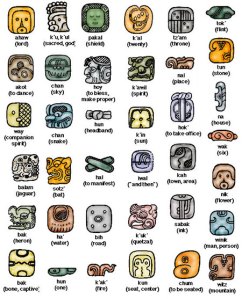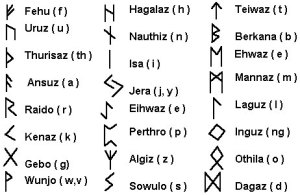Symbols part 1

Mayan Glyphs
Maya writing consisted of relatively elaborate set of glyphs, which were laboriously painted on ceramics, walls or bark-paper codices, carved in wood or stone, or molded in stucco. Carved and molded glyphs were painted, but the paint has rarely survived. About 90% of Maya writing can now be read with varying degrees of certainty, enough to give a comprehensive idea of its structure.
The Maya script was a logosyllabic system. Individual symbols (“glyphs”) could represent either a word (actually a morpheme) or a syllable; indeed, the same glyph could often be used for both. For example, the calendaric glyph MANIK’was also used to represent the syllable chi. (It’s customary to write logographic readings in all capitals and phonetic readings in italics.) It is possible, but not certain, that these conflicting readings arose as the script was adapted to new languages, as also happened with Japanese kanji and with Assyro-Babylonian and Hittite cuneiform. There was ambiguity in the other direction as well: Different glyphs could be read the same way.

Runes
Runes are an ancient Germanic alphabet, used for writing, divination and magick. They were used throughout northern Europe, Scandinavia, the British Isles, and Iceland from about 100 B.C.E. to 1600 C.E. Runic inscriptions of great age have even been found in North America, supporting stories that the Vikings arrived in the Americas long before Columbus.
Tacitus, in Chapter X of his Germania, describes a form of divination used by Germanic tribes:
“To divination and casting of lots, they pay attention beyond any other people. Their method of casting lots is a simple one: they cut a branch from a fruit-bearing tree and divide it into small pieces which they mark with certain distinctive signs and scatter at random onto a white cloth. Then, the priest of the community if the lots are consulted publicly, or the father of the family if it is done privately, after invoking the gods and with eyes raised to heaven, picks up three pieces, one at a time, and interprets them according to the signs previously marked upon them.”
I’ve been working with Runes since 1994, when I was introduced to their use at a family reunion. I’m of Norse heritage. I believe that this is why I found a natural affinity to runes, although one certainly does not need to be Scandinavian to use them.
Runes are an oracle from which one seeks advice. They work best if you detail your current circumstances and then ask a specific question. Rune readings are sometimes obscure. They hint toward answers, but you have to figure out the details. This is when the rune casters intuition becomes paramount. Some times the Runes “sing” to me, and their meaning becomes instantly clear.
Runic divination or “rune casting” is not “fortunetelling” in the sense that one actually sees the future. Instead, runes give one a means of analyzing the path that one is on and a likely outcome. The future is not fixed. It changes with everything one does. If one does not like the prediction, one can always change paths.
Since ancient times, runes have been used for divination and magic, in addition to writing. The word “rune” actually means mystery, secret or whisper. Each rune has esoteric meanings and properties associated with it, beyond its mundane meaning and phonetic value. Each translates into a word or a phrase signifying concepts important to the early peoples who used them, representing the forces of nature and mind. Each rune has a story attached to it, a relationship to a Norse God.
Odin, the Norse High God of the Aesir, hung from the world tree, Yggdrasil, impaled on his own spear, for nine days and nights in order to gain the knowledge of runes. When the runes appeared below him, he reached down and took them up, and the runic knowledge gave him power . He later passed on this knowledge to the Vanir goddess Freya. She, in turn, taught him the magic of seidr. Heimdall, the god who guarded the Rainbow Bridge, taught the runes to mankind.
Runic alphabets first appeared among German tribes in central and eastern Europe. Some runes symbols are likely to have been acquired from other alphabets, such as the Greek, Etruscan, and the Early Roman. The runes were made of straight lines to make the characters suitable for cutting into wood or stone. The earliest runic inscriptions on stone are dated to the late 3rd century AD, although it is probable that runic alphabets had been in use for some centuries before.
The Old Germanic Runic alphabet or “Elder Futhark” contains 24 runes. The first six runes of the alphabet spell out the word “FUTHARK”. As the runes spread northwards into Scandinavia, some rune symbols were dropped and the alphabet was reduced to only 16 runes. Between 400 and 600 AD, three Germanic tribes, the Angles, the Saxons and the Jutes, invaded Britain. They brought the runes with them. The forms of several of the runes changed, notably the runes for A/O, C/K, H, J, S, and Ng. Also, changes in the language led to nine runes being added to the alphabet to compensate for the extra sounds, and several runes were given different corresponding letters. This alphabet, expanded to 33 symbols, has become known as the Anglo-Saxon Futhorc. The rune names themselves have been passed down relatively intact. Although no manuscript exists listing the names of the older, Germanic runes, the Anglo-Saxon and Scandinavian rune poems agree to such an extent that their common origin can be deduced. Here you can see number of Runic Scripts
The Runes are divided into three Aettir or groups of eight. D. J Cooper discusses the significance of the Aettir in understanding the runes and using them in magick.
On the other pages of this website you’ll find information on rune casting, making a rune set, rune magick, recommended reading, etc. These pages are directed to the curious, the beginning runester, and the runemaster.
One who aspires to become adept with runes must have some knowledge of the mythology, history, and culture of ancient Europe and Scandinavia. The kenning of runelore is inextricably dependent upon these. Much of what you find here will merely point you in the right direction. The rest is up to you. Delve as lightly or as deeply as you wish. I hope you fall in love with runes as I have.

Alchemy Symbols
The art of alchemy was handed down through the centuries from Egypt and Arabia to Greece and Rome, and finally to western and central Europe. The word is derived from the Arabian phrase “al-kimia,” which refers to the preparation of the Stone or Elixir by the Egyptians. The Arabic root “kimia” comes from the Coptic “khem” that alluded to the fertile black soil of the Nile delta. Esoterically and hieroglyphically, the word refers to the dark mystery of the primordial or First Matter (the Khem).
Simplified, the aims of the alchemists were threefold: to find the Stone of Knowledge (The Philosophers’ Stone), to discover the medium of Eternal Youth and Health, and to discover the transmutation of metals. To the medieval alchemist’s mind the different elements were but the same original substance in varying degrees of purity. Gold was the purest of all and silver followed closely.
In the early days of alchemy, the astronomical signs of the planets were also used as alchemical symbols. Then in the centuries of medieval persecution and suppression every alchemist invented his own secret symbols. Charlatans, quacks and cheats took over and alchemy became, along with sorcery and witchcraft, infamous for fraud and extortion. In the 18th century scientists tried to pry loose the real achievements in chemistry, pharmacology and medicine from this confusing cornucopia of science and magic.



Leave a comment